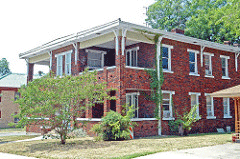
Photo by Steven Martin, via flickr, CC BY-NC-ND 2.0
An op-ed last week here on Rooflines, called “Duty to Serve = Your Duty to Comment,” by Michael Bodaken and Ellen Lurie Hoffman, highlights several proposals within FHFA’s new Duty to Serve rule that they believe warrant our field’s closer inspection and comment. In the post, they assert:
“While we strongly support new construction deals with long-term affordability restrictions in high opportunity areas, we firmly reject including such housing within the ‘preservation’ category in this rule … We strongly discourage FHFA from categorizing this activity as a subset of preservation because including ‘new construction’ within ‘housing preservation’ … dilutes the very concept of preservation. Of course we urge Fannie and Freddie to provide preservation incentives in higher opportunity areas, but within their housing goals, not as part of their Duty to Serve.”
I have to disagree with the unduly limited definition of “preservation” in this piece. The real focus of preservation—and the definition—should be on the bigger picture of preserving the assisted/affordable housing stock in a community or region—the numbers of units available to meet the housing needs of people living in an area—and not just on the smaller picture of the fate of individual properties.
Preservation of the inventory does not only or always entail acquisition and rehabilitation of an individual building or project. Rehabilitation of an existing project is not always feasible or the best strategy for meeting the housing needs of the residents of the developments, much less of the community generally. In some cases, it is safer for residents and/or more cost effective, desirable, or strategic to shift the operating subsidy and available capital funding to another location(s).
But Bodaken and Hoffman would limit the definition of “preservation,” and thereby FHFA’s Duty to Serve, to rehabilitation of existing buildings, as and where they are, even excluding new replacement housing in another location.
One problem with this cramped view is that when it has been infeasible or undesirable to rehab a specific project—or simply when no one stepped forward to do so—both the units and the subsidy have been lost altogether to the area’s inventory of affordable housing (e.g. where the project is near an environmental hazard, in an unsafe area, few tenants want to stay, lacks the unit mix to meet current needs, or is too deteriorated to feasibly be rehabbed.) The fate of our affordable housing inventory, and the families that depend on it, should not be so tied to the fate of specific properties and sites.
Another problem with Bodaken and Hoffman’s proposed definition is that it assumes the inherited geography of segregation in the locality and region will be re-upped for another 40 plus years. This is neither morally nor legally acceptable. FHFA could and should be playing an active role in correcting the mistakes of the past by helping to finance expanded housing choice and opportunity.
In short, the limited definition proposed in the piece for FHFA’s duty to serve would unduly restrict FHFA in meeting both its preservation mission and its duty to affirmatively further fair housing.





Barbara: Thanks for your February 8 comment in response to our earlier post. We wanted to add a few clarifications which we hope dramatically reduces the distance between NHT’s views and your own on the Federal Housing Finance Agency’s (FHFA’s) proposed Duty to Serve rule:
1. As mandated by the Housing and Economic Recovery Act of 2008 (HERA), the Duty to Serve rule does not have quantitative requirements. The statute directs the Enterprises toward activities that facilitate a secondary market for mortgages related to manufacturing housing, preserving affordable housing, and rural housing.
2. As we stated previously, we strongly support the Enterprises getting credit in their Affordable Housing Goals, which, unlike the Duty to Serve, have strict numerical requirements, for new construction of subsidized and other affordable housing,.
3. We strongly support the Enterprises receiving Duty to Serve credit, as mandated by HERA, for preserving existing, affordable, subsidized housing including, of course, the need to preserve existing, affordable, subsidized housing in high opportunity areas.
4. HERA, specifically referred to existing subsidized housing in its examples for affordable housing preservation, to wit:
“(i) the project-based and tenant-based rental assistance programs under section 8 of the United States Housing Act of 1937;
(ii) the program under section 236 of the National Housing Act;
(iii) the below-market interest rate mortgage program under section 221(d)(4) of the National Housing Act;
(iv) the supportive housing for the elderly program under section 202 of the Housing Act of 1959;
(v) the supportive housing program for persons with disabilities under section 811 of the Cranston Gonzalez National Affordable Housing Act;
(vi) the programs under title IV of the McKinney Vento Homeless Assistance Act (42 U.S.C. 11361 et seq.), but only permanent supportive housing projects subsidized under such programs;
(vii) the rural rental housing program under section 515 of the Housing Act of 1949;
(viii) the low-income housing tax credit under section 42 of the Internal Revenue Code of 1986; and
(ix) comparable state and local affordable housing programs.”
Again, we thank you for your comment. We believe there are ways for us to strongly agree that the Enterprises actually promote and preserve affordable housing in high opportunity areas and receive significant new credit for actually delivering (not just developing) products that promote new affordable housing, including in high opportunity areas.